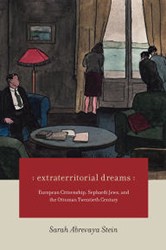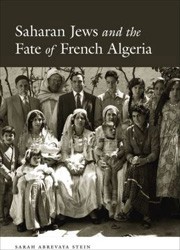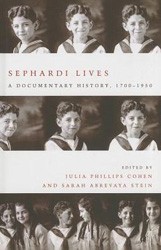The thirst for exotic ornament among fashionable women in the metropoles of Europe and America prompted a bustling global trade in ostrich feathers that flourished from the 1880s until the First World War. When feathers fell out of fashion with consumers, the result was an economic catastrophe for many, a worldwide feather bust. In this remarkable book, Sarah Stein draws on rich archival materials to bring to light the prominent and varied roles of Jews in the feather trade. She discovers that Jews fostered and nurtured the trade across the global commodity chain and throughout the far-flung territories where ostriches were reared and plucked, and their feathers were sorted, exported, imported, auctioned, wholesaled, and finally manufactured for sale.
From Yiddish-speaking Russian-Lithuanian feather handlers in South Africa to London manufacturers and wholesalers, from rival Sephardic families whose feathers were imported from the Sahara and traded across the Mediterranean, from New York’s Lower East Side to entrepreneurial farms in the American West, Stein explores the details of a remarkably vibrant yet ephemeral culture. This is a singular story of global commerce, colonial economic practices, and the rise and fall of a glamorous luxury item.
Ruffling Feathers
By Sarah Abrevaya Stein
In 2004, on a research trip to South Africa, I took leave of the book I was researching, leaving the archives of Cape Town for Oudtshoorn, a small town on the interior of the Western Cape. Oudtshoorn had been the primary supplier to a global ostrich feather industry of the late 19th and early 20th century, and, according to a 1940 Yiddish-language history, Jews had counted prominently among its feather dealers. This unlikely confluence — that an ostrich feather boom existed, that Jews had a role in it, and that its only history should be penned in Yiddish — warranted an archival pilgrimage.
The archives of Oudtshoorn’s C.P. Nel Museum, small and low tech but lovingly maintained, revealed fascinating traces of Jewish history. It did not, however, yield papers of Jewish feather traders — documents that might allow me to reconstruct their history. Sharing my frustration with my informal hosts, third generation Jewish ostrich farmers in their eighties, they gently suggested I was looking in the wrong place: the material I craved, they explained, was not preserved in Oudtshoorn’s archives, but was on display in the associated museum. Jews’ involvement in the global ostrich feather industry, it seems, was viewed less as the stuff of history, more as a cabinet of curiosities.
Returning to the museum, I discovered an “ostrich feather merchant’s office” containing roughly 30 years of the quotidian financial records of Isaac Nurick, a Jewish feather merchant of Russian Lithuanian origin well connected across the global feather world. Blessed with access to this astonishing treasure, I was launched on a historical journey that carried me to three continents, to troves of hitherto neglected archives, to the descendents of feather families in six countries, and to the unexpected story of Jews’ prominence in the ostrich feather boom and bust of the turn of the 20th century, the subject of Plumes.
Due to the overwhelming thirst for plumes as items of adornment by female consumers in the metropolises of Europe and the United States, the value of ostrich feathers per pound almost equaled that of diamonds. For some 40 years, from the 1880’s to roughly World War One, ostrich plumes proved a popular decorative element and ubiquitous feature of trans-Atlantic women’s fashion. Ostrich feathers could be found wherever there were arbiters of style: a consignment of £20,000 worth went down with the Titanic.
Astonishingly, in all hubs of the global feather trade — North and South Africa, Yemen, London, Paris, and New York — Jews were the principal plume middle-men and women. In the Western Cape, over 90% of feather merchants were Yiddish-speaking immigrants from Russian Lithuania. In North Africa, whence the feathers of wild ostriches were shipped, Sephardi Jews dominated feather exports and Judeo-Arab Jews dominated the feather processing industry. In Yemen, Jews oversaw the sale of feathers of Arabian origin at Aden’s bustling port. In London, the ostrich feather trade was considered one of the city’s “chief Jewish monopolies.” In New York, the American center of ostrich feather manufacturing, most feather workshops were owned by Jewish men and staffed by Russian Jewish women. In the American West, Southwest, and South, Jews constituted the financiers and “feather go betweens” for entrepreneurial ostrich farmers.
Plumes explores how Jews nurtured the feather trade across a global commodity chain and throughout the far-flung territories where ostriches were reared and plucked, and how their feathers were sorted, exported, imported, auctioned, wholesaled, and finally manufactured for sale. The book considers how Jewishness was a magnet to the industry for some, for others a tonic that facilitated commercial relationships. How, I ask, did Jews in various echelons of the ostrich feather market benefit from the particular skills, expertise, and contacts they possessed as Ashkenazi, Sephardi, Maghrebi, and Anglophone Jews — and as rich and poor, immigrant and native-born, South African, Mediterranean, British, and American girls, boys, women, and men? Why did Jewishness prove to be the crucial ingredient that knit together this lucrative but ultimately short-lived market?
While the fact of being Jewish helped some in the feather trade, it insulated none when the industry entered a precipitous collapse in 1914 — brought on by shifts in fashion catalyzed by World War I, rampant over-supply, and the success of the international bird preservation movement. The feather crash brought financial disaster across the globe and to all in the business, Jewish and non-Jewish. The most tenacious tried to ride out the bust; many more were left bereft of business, pride, and reputation. Slums in South Africa housed entire communities disenfranchised by the crash, feather merchants committed suicide rather than face their debts, husbands sold their wives’ jewelry to remain solvent.
One does not write a book about Jews and feathers with the expectation that it will prove timely. And yet the contemporary resonance of this story is breathtaking. At the moment Plumes appeared, news of a global financial downturn, of the catastrophic devaluation of goods and industries once viewed as inviolate, and, no less, of Jewish wealth, loss, and economic misbehavior dominated the airwaves. For this, the history of the ostrich feather industry of the last turn-of-the-century offers a poignant historical model. It suggests, first, how fallacious is the assumption that things have an enduring and knowable value: how wrong it is to assume that profits earned in a speculative, volatile, and inflated market are guaranteed, even deserved. Second, it teaches that Jewish histories are found in unexpected places. To fathom Jewish commerce, cultures, and lives in all their multiplicity, we must be prepared to peer beyond the places, leitmotifs, and sources that have been considered central to the Jewish experience heretofore, finding new cabinets of curiosity whose weighty histories are yet to be written.





